Review: LES MISERABLES Offers Hope for the Hopeless(ly Devoted) at Dr. Phillips Center
Les Misérables, though it may be about a failed rebellion that lasted a mere two days, teaches us to embrace the failures of our lives in order to strengthen our ideals and passions for a better tomorrow.

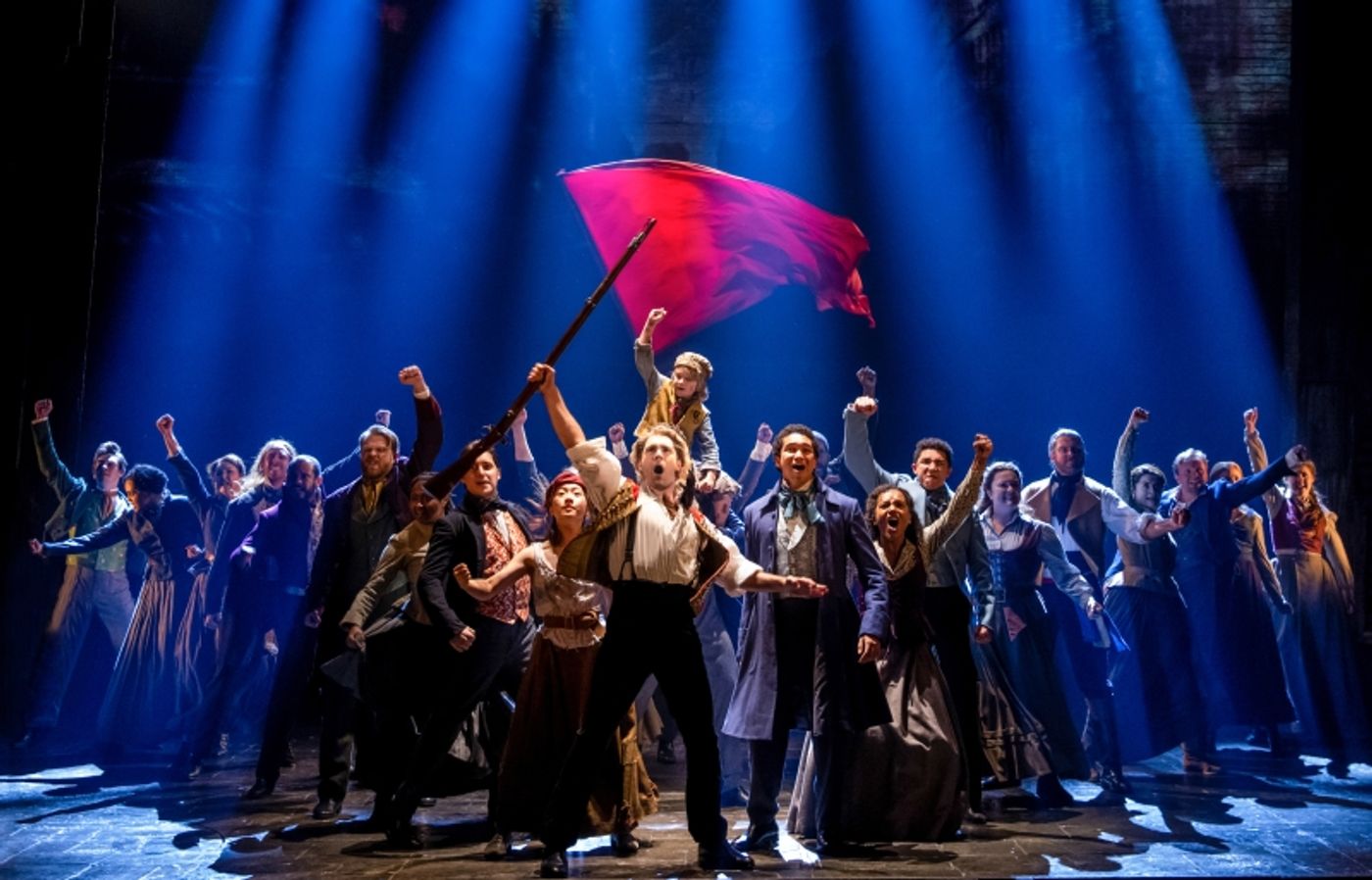
At the height of its fame, the musical Les Misérables was the Dorsia of Broadway, a hot-ticket event that reached Hamilton levels of excessive prices, elite A-list attendees, and legions of fans who’d revisit the show through repeat viewings, memorization of the cast recording, and fierce debates of West End vs. Broadway performers. In the years since, with various tours, revivals, concert specials, and that 2012 Tom Hooper film comprised of extreme close-ups to show everyone sang live on-set, the phenomenon of Les Misérables has now become as familiar and comforting as an old “Golden Girls” rerun. The impact cannot be denied, the bleeding-heart sentimentality cannot be matched, and the songs cannot get out of your head.
Sure, you’ll have your favorite episode or song, while trying to trudge through a couple weaker ones, but will always reach that wedding finale wishing it could go on for just a bit longer. You may have seen the show one or one hundred times, but that sense that Something Long and Important is Happening never leaves you. The core audience for Les Misérables grows older every year, but new ones are always waiting in the wings. It belonged to and birthed an entire generation of theatre-lovers, while still accessible to younger Broadway acolytes with a vested interest in what came before their place in the sun. The story of young citizens fighting for justice and a new world order only shows that the world we leave behind for our posterity will always have a hopefulness that change is going to come.
At least, that’s what we choose to think. The sad reality of Les Misérables is that this show, and its original 1862 Victor Hugo novel, is about systemic failure. Time and again, through a prologue and two acts, we see failure on a grand scale: a broken justice system, a man excessively punished for theft, a mother shamed for providing for her child, a generation of young radicals dying for their cause. I can’t think of another musical where eighty percent of the characters end up dead as the survivors are left to pick up the pieces. It’s a bloody massacre that surely suggests some goals may never be reached because the system and the complacency of the people simply will not allow it. All the efforts of one character meets resistance by another. The unrequited love of one goes unnoticed by the other. Abject failure defines these characters and their stories from beginning to end, so why has Les Misérables become such an enduring classic?

Because, life reminds us, our failures must define us just as much as our successes. If we never fail, we would never understand the satisfaction of success. If we always got what we want, we could not appreciate the true quality of our achievement. If everybody wins, then the game of life has only reached a stalemate. In order to better love the complicated and frustrating nature of this competition called Living, we have to fail a few times in order to want to win. Les Misérables, though it may be about a failed rebellion that lasted a mere two days, teaches us to embrace the failures of our lives in order to strengthen our ideals and passions for a better tomorrow.
In the grand scheme of French history, the June Rebellion was a blip on the radar. Many know of the first French Revolution that ended the monarchy in 1793, famously beheading Louis XVI and introducing a democratic republic in 1799. However, the French Empire fell in 1814 and a new monarch was instated in 1824, King Charles X. This led to a second French Revolution in 1830, with Charles X overthrown and Louis-Philippe being crowned king of the French people. French republicans who a generation ago lived in a democratic nation were incensed at having a second monarch foisted upon them, while Legitimists still loyal to the royal family supported the restoration of Louis-Philippe. 1832’s June Rebellion was but one of several demonstrations against the monarchy, bearing little impact as it would take sixteen long years before the third French Revolution of 1848 finally removed the royal family from French government.
Of course, I’m oversimplifying over sixty years of French history, although knowing this contextual information does help to enhance one’s appreciation for Les Misérables as a musical.as it strips down Hugo’s 1862 novel to a core story about the hope birthed after failure. Hugo’s novel drew inspiration from encounters across his own lifetime, including his activity during the June Rebellion. He chose to memorialize this failed revolution in order to both glorify the idealism of the republicans, as well as criticize the fallacies of the laws of man when in contrast to the moral goodness of God. It’s a truly dense read, one which goes into far more than the story we see in the musical. However, as stated before, the musical filters and extracts the spirit of that novel into a sentimental tale with much broader appeal. It takes the failure of the June Rebellion and turns it into an enduring story of hope for those who survive.

Both the book and the musical span across a timeline of seventeen years, offering lengthy backstory before the June Rebellion even occurs. This backstory builds up our relationship with fictional characters based on historical figures, starting in 1815 with Jean Valjean (Nick Cartell) getting released from prison by his parole officer, Javert (Preston Truman Boyd). Javert aggressively upholds the letter of the law, giving Valjean a “ticket of leave” that will forever identify him as an ex-convict, thus greatly restricting whatever work he is able to get. The Bishop of Digne (Randy Jeter) offers food and lodgings to Valjean, who repays this generosity by stealing silver from the church. He is captured by Javert, but the Bishop lies that he gave the silver to Valjean, offering a pair of candlesticks as well. Javert reluctantly lets Valjean go, as the Bishop pleads to Valjean to use this opportunity to become a good man. Valjean promises to do so, breaking the law by tearing up his ticket of leave, that he may start anew.
Eight years later, 1823, Valjean has now become the mayor of Montreuil-sur-Mer, having used the silver to run a factory and build his wealth. Among the workers at his factory is Fantine (Haley Dortch), who sends her wages to Monsieur Thénardier and his wife (Matt Crowle and Victoria Huston-Elem, respectively) as they care for her daughter Cosette (Azalea Wolfe). After Fantine rejects the advances of a foreman (Steve Czarnecki), another Factory Girl (Julia Ellen Richardson) exposes Fantine’s secret child and the two fight. Fantine finds herself penniless on the streets, resorting to prostitution to earn money, but gets arrested by Javert when she strikes back at a prospective client who beat her. Valjean comes across the situation and tries to make amends for Fantine’s dismissal by taking her to recover in a hospital. Javert feels he recognizes Valjean, his suspicions confirmed upon witnessing a feat of strength that Valjean could have only developed through prison labor. He goes to confront Valjean in the hospital, where Fantine has died. Before her death, Valjean promised the woman he would raise Cosette, and now pleads to Javert to let him go and rescue the child. Javert, only supportive of the law he knows, refuses. In a struggle, Valjean defeats Javert and goes to find Cosette. The Thénardiers have turned her into a servant in their own house while spoiling their own daughter Eponine (Ava Buesing), though they accept Valjean’s offer of 1500 francs to take Cosette away.
Nine years later, 1832, Paris has been riddled with plague, poor economy, and food shortages. Street urchin Gavroche (Milo Maharlinka) explains how the people have suffered under King Louis-Philippe, seeing their only hope for change in General Lemarque, an outspoken supporter of government reform for the benefit of the working class. Student revolutionaries Marius (Jake David Smith) and Enjolras (Devin Archer) lead demonstrations and a call to arms for the people to strike against the French government. The Thénardiers have resorted to pickpocketing and swindling people in the street, sometimes using their now-grown daughter Eponine (Mya Rena Hunter) in their schemes. Eponine carries a torch for Marius, who is stricken with love at first sight upon meeting a now-grown Cosette (understudy Eden Mau). She and her father Valjean are visiting Paris, but very nearly become victims of a Thénardier con. Javert breaks it up, once again suspecting he knows Valjean. Marius wishes to meet Cosette, convincing Eponine to help him find her. They share a tender moment. Later, Gavroche brings news to the students that Lemarque is dead. Enjolras decides that now is the time to fight, as they plan to strike the government at Lemarque’s funeral. The Rebellion has begun.
All of this just occurs in Act One, by the way.

Act Two comprises the entirety of the June Rebellion and the aftermath. Again, this is a very dense story that goes by at such a rapid pace that I feel anyone new to Les Misérables should do some homework before even attending a show. A rudimentary breakdown of the characters and main plot points will yield a better appreciation for the show, its songs, and the emotional back and forth it asks of the audience. Les Misérables wears its heart on its sleeve as prominently as Javert wears his gaudy Inspector hat. There is no room for subtlety or nuance here, everything is boldly depicted in clear displays of anger, disappointment, longing, regret, love, and death. In the face of failure, it ultimately boils down to one simple credo: saving even just one person can be enough. Enough to change the tides of war, enough to ensure a story gets told, enough to bring redemption to the soul.
It’s that “enough” that makes Les Misérables such a classic today. It knows how much it gives to its audience, and gives just a bit more to make it worth it. There’s a reason why this show has toured multiple times for multiple years. The last time Les Misérables brought their story to Central Florida, COVID-19 was merely a concern from halfway around the world. No one could have anticipated that its 2017 tour would closed suddenly in 2020, waiting two more years to get mounted once more. The 2022 tour has one more year left before retiring in August 2025, including more stops in Florida. However, those in Orlando only have this final week in June to witness the majesty and grandeur of this popular musical.
All of the sets, staging, and pacing are taken from the all-new 2019 remounting of the show, which is meant to quicken the pace of the sung-through musical while still maintaining its spirit. I have to say, this quickened pace is one of my criticisms of the show. Act One runs a strict 90 minutes (the doors closed at 8:00 pm on the dot and would not reopen for latecomers until after the Prologue), while Act Two concludes after 75 minutes. This 165 minute running time does put the the musical a shade over the 2012 film (at 158 minutes), but also well under the 25th anniversary concert (186 minutes). I cannot find accurate running times for the original 1985-2019 mounting, although given how the show always had a “Long, but Important” reputation, the quickened pace may have been a necessity.
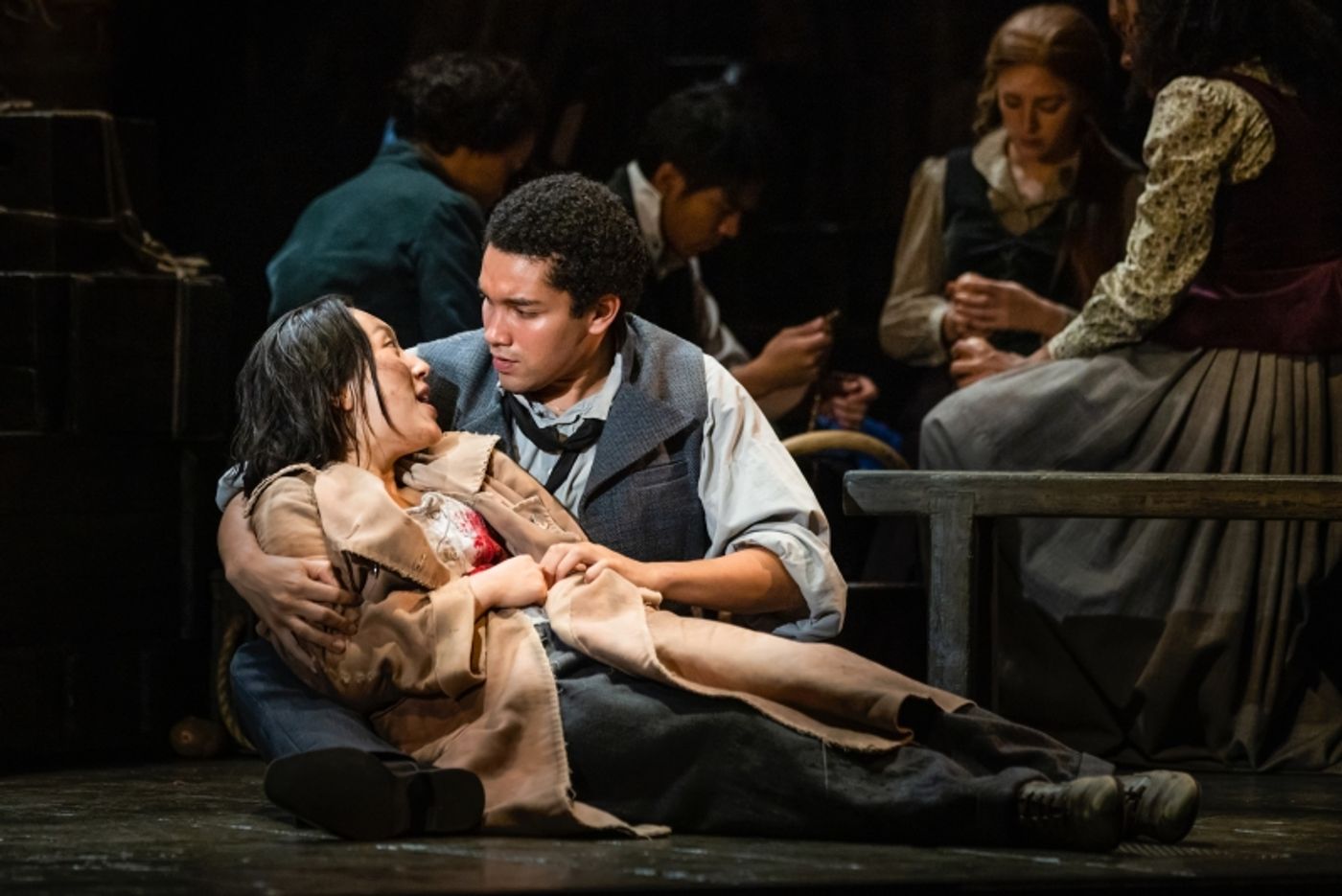
The problem with this pacing, sadly, is that we are robbed of important pauses and moments within key songs. The scene changes sometimes happen instantaneously, even mid-applause at the conclusion of one song to expedite the beginning of the next one. “Do You Hear the People Sing?” has long been the theme song of Les Misérables, but the audience were barely done clapping its performance when they launched into the wonderstruck lovebirds Marius and Cosette’s “In My Life.” In Act Two, we are afforded a brief pause at Eponine’s death during “A Little Fall of Rain,” but the cast are already pulling out Javert in chains for the opening bridge of “Drink with Me to Days Gone By.”
The most egregious of these quickened pacing offenses occurs as “Empty Chairs at Empty Tables” gives way to “Wedding Chorale.” Marius’ mourning almost immediately transitions to the undefined some-months-later as he and Cosette get ready for the wedding. The sudden shift in emotion from grieving to glee merely makes the production feel like they’re rushing to meet a deadline rather than allowing the audience to ease into the next moment.
However, after 34 years, perhaps an argument can also be made that audiences already familiar with Les Misérables would want to simply “get on with it” after already being put through the emotional wringer for two hours. Performers, too, know when they should take the pause. Preston Truman Boyd and Mya Rena Hunter both knew to let the audience finish applauding after “Stars” and “On My Own,” as those two songs often bring the lengthiest of claps. Nick Cartell, perhaps used to singing “Bring Him Home” for the past seven years, was more experienced in making a motion – subtle, but effective – to clue the audience that he was content with their applause and needed to move into the next scene. Almost as if we were reading that direction, the applause halted as the orchestra swelled back into the next scene.
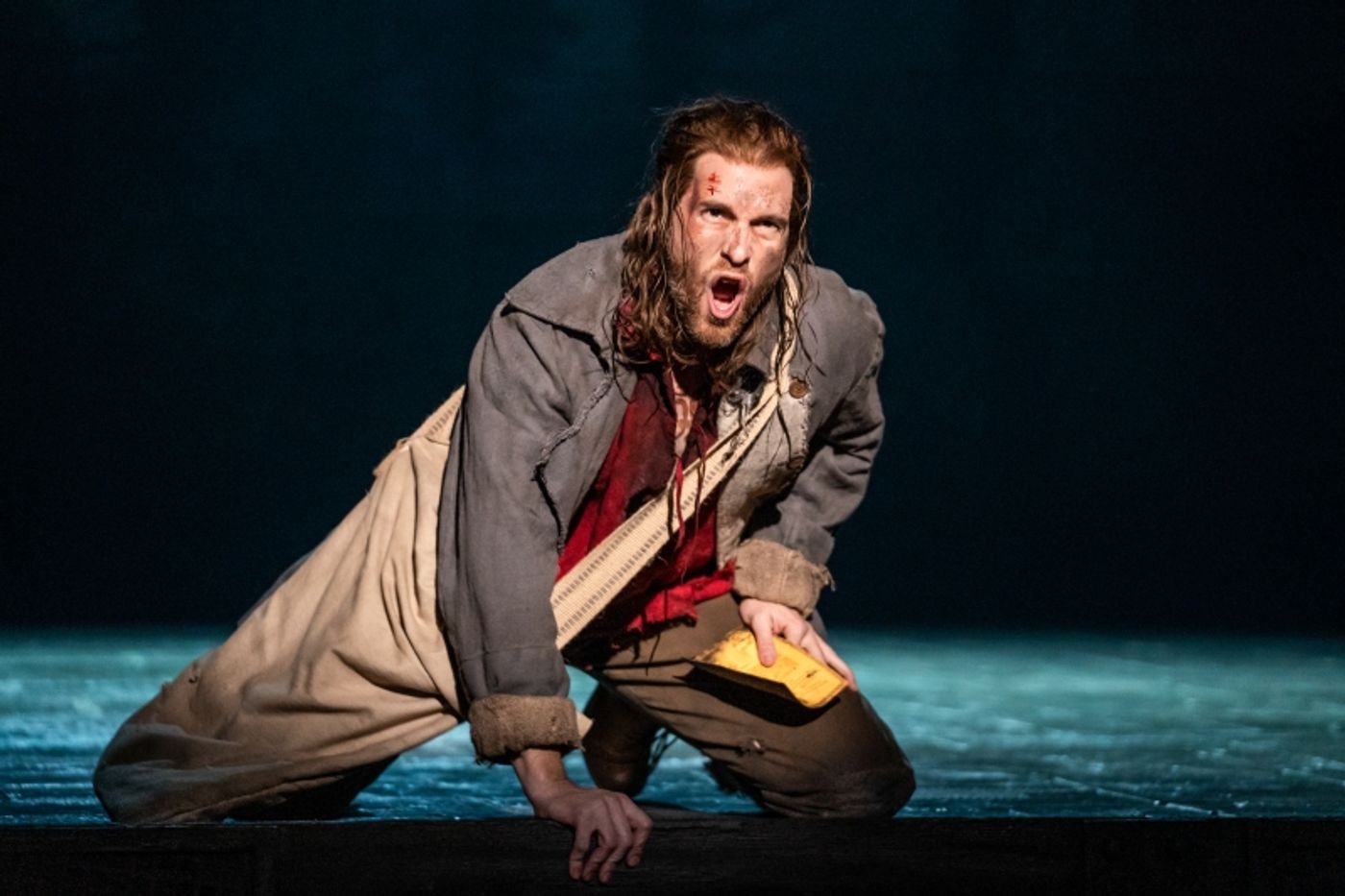
As mentioned before, Cartell has been portraying Valjean since the 2017 tour began. Aside from the pause from covid’s halting of the tour, he’s otherwise been with the show all these years. Five years ago, Broadway World noted how his rock star voice is perfectly suited for Les Misérables. Five years on, it still holds true. However, the passage of time does bring with it reminders of our own aging. Cartell’s rock-star voice is still here, belting as ever. But there was a more natural cadence by the end of Act Two, when Valjean’s elderly self is ready to die. He’s not belting, but including a greater vulnerability to his singing voice. The pitch-perfect high notes he held in Act One were now replaced with a gentle, occasional crack to his voice. It made for a compelling performance of a man – once young and vibrant at the beginning of the show – now willing to face death with a readiness and acceptance.
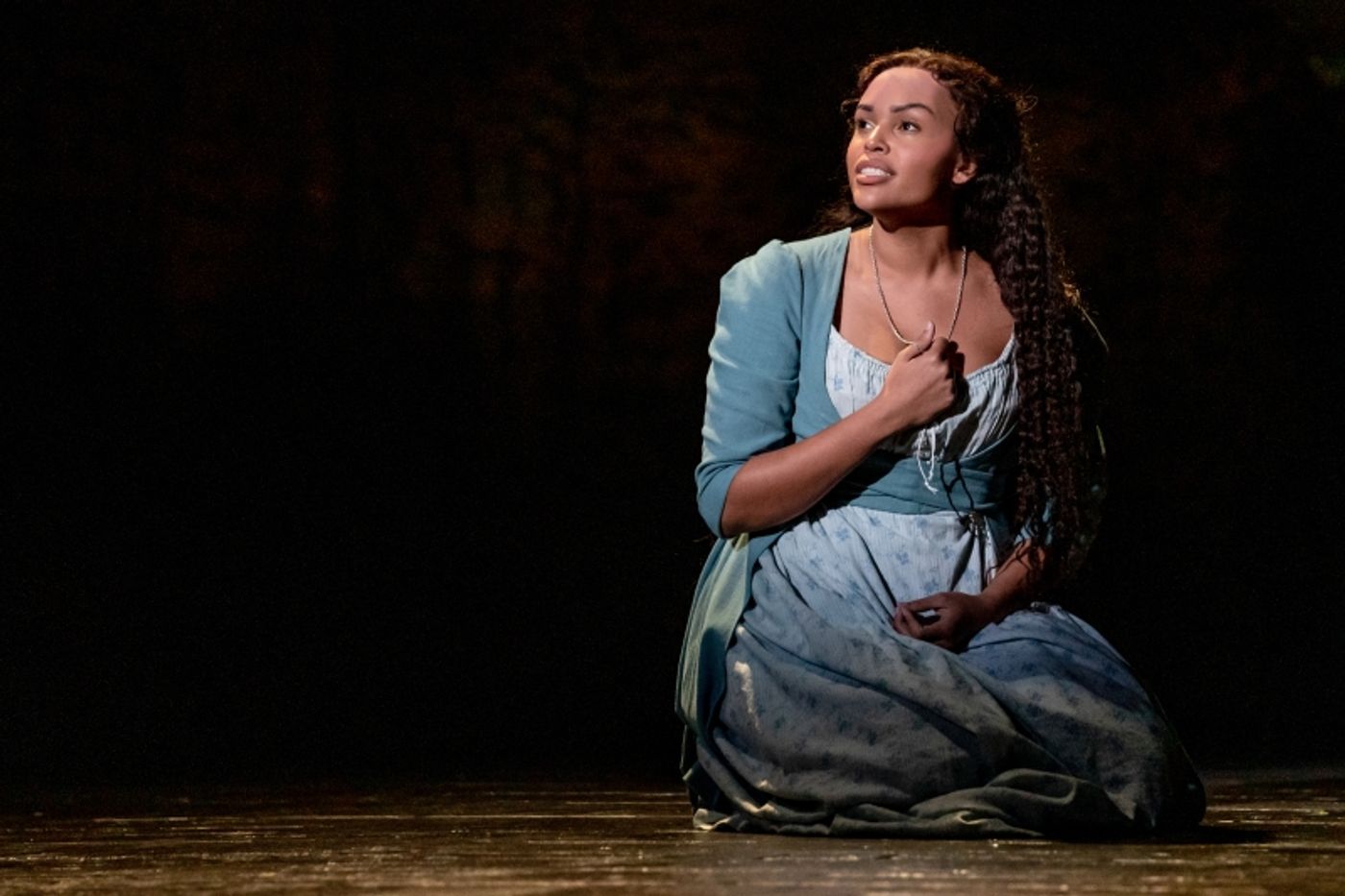
This national tour also includes a variety of newcomers to Les Misérables including standout performers Haley Dortch (Fantine), Mya Rena Hunter (Eponine), and Eden Mau (Cosette, understudy). Dortch’s “I Dreamed a Dream” won the audience over, but it was her soothing rendition of “Come to Me” during the finale that elicited tears. The aforementioned Hunter earned the lengthy applause after “On My Own,” but also brought a newfound sensitivity and pain to “A Little Fall of Rain,” admittedly my favorite song in the musical. Mau, who normally performs the Ensemble, filled in for Delaney Guyer in the evening’s performance I attended. Cosette’s songs don’t often have as much vibrancy compared to those of Fantine and Eponine, but Mau made “A Heart Full of Love” feel ethereal and romantic even if the coupling of Cosette and Marius does feel a little silly given how quickly the fall in love and marry in the story.
Typically, productions of Les Misérables will have audiences split between Valjean and Javert as to who’s most effective in the role. Both characters are compelling with truly outstanding songs and voices under their belt. But it’s a fun fandom argument to have at any production. This time around, Cartell had the benefit of time on his side, having refined his Valjean over seven years. Thus, Preston Truman Boyd has his work cut out for him as he and Cartell must make the “Confrontation” two-fer legible despite singing on top of each other. He holds his own very well opposite Cartell, but also manages to turn Javert into a more sympathetic figure throughout Act Two. His suicide scene also includes a new effect included in the 2019 remounting that, personally speaking, swayed this reviewer to Team Javert in the final seconds. We’ll see if Team Valjean succeeds in a rematch next year.
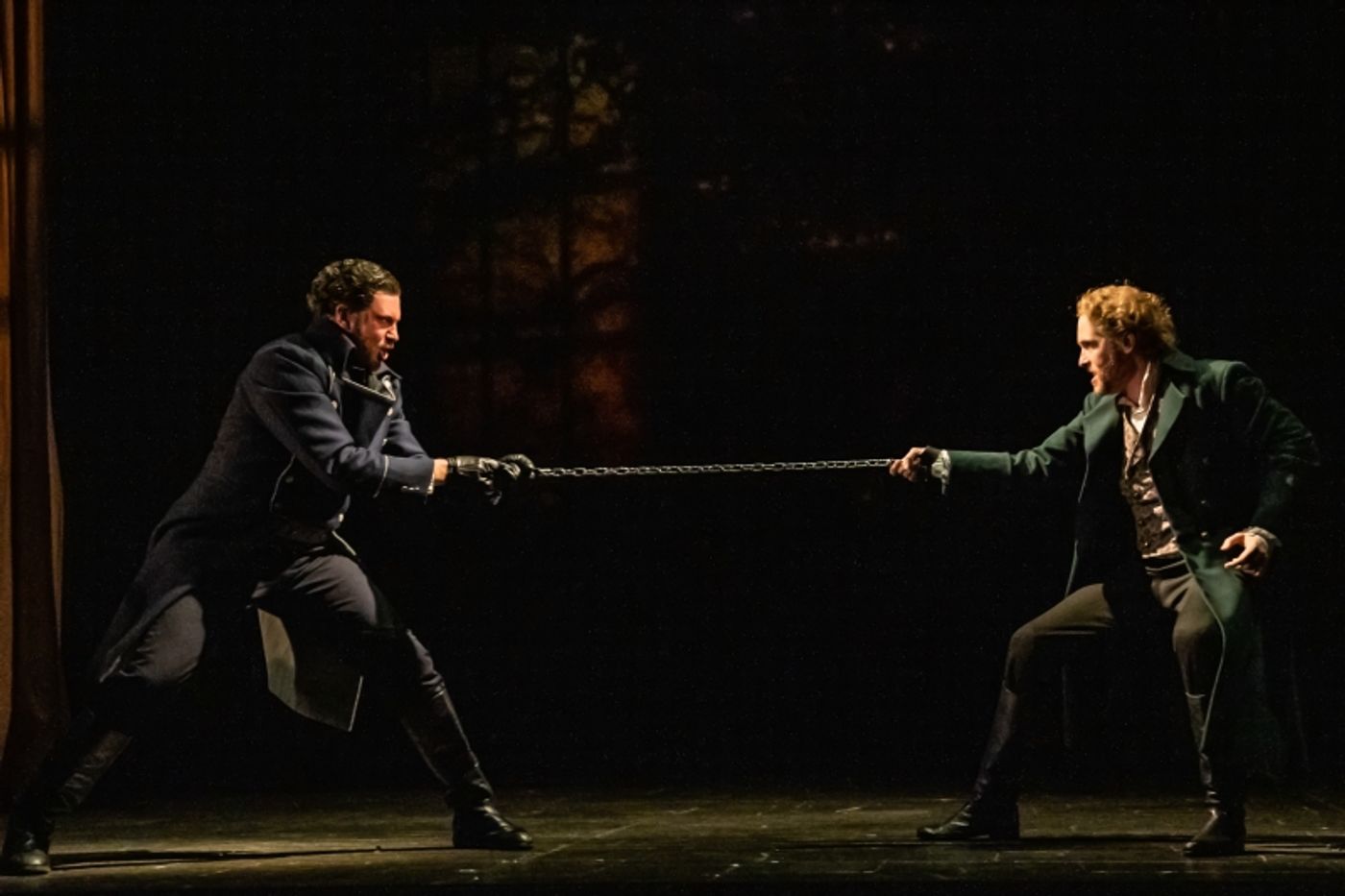
The Thénardiers are portrayed by the comically-talented artists Matt Crowle and Victoria Huston-Elem. Both characters sometimes feel out of place among the seriousness of the rest of the story, their opportunistic and humorous moments serve mainly to add a bit more levity. Even their costumes are intentionally more outlandish than the other characters, almost as if they were pulled from an Italian commedia dell’arte rather than an approximation of 19th century France. I don’t often enjoy the Thénardiers scenes in other productions, but Crowle and Huston-Elem had me laughing, smiling, and occasionally shaking my head in silly approval of just how humorous they approached their characters.
When it comes to the participants of the June Rebellion, the student revolutionaries are led by Enjolras (Devin Archer) and Marius (Jake David Smith), supported by a variety of young men: Combeferre (Andrew Marks Maughan), Feuilly (Daniel Gerard Bittner), Courfeyrac (Danny Martin), July (J.T. Wood), Grantaire (Kyle Adams), Lesgles (Randy Jeter), and Jean Prouvaire (David Young Fernandez). That’s a lot of names for a lot of characters, most of whom get lost in the shuffle on the stage. Marius, with his additional story as Cosette’s paramour, is easily identifiable. Likewise, Enjolras wears a distinctive red vest to clue us in that he is the leader of the pack. However, the rest of the students must create personalities to let us know which character they are. A standout among these personalities is the fun-loving Feuilly, who seems to be rebelling for sport and drink, although he notably is affected by the death of Gavroche, cradling the boy as he lays him upon the ground.
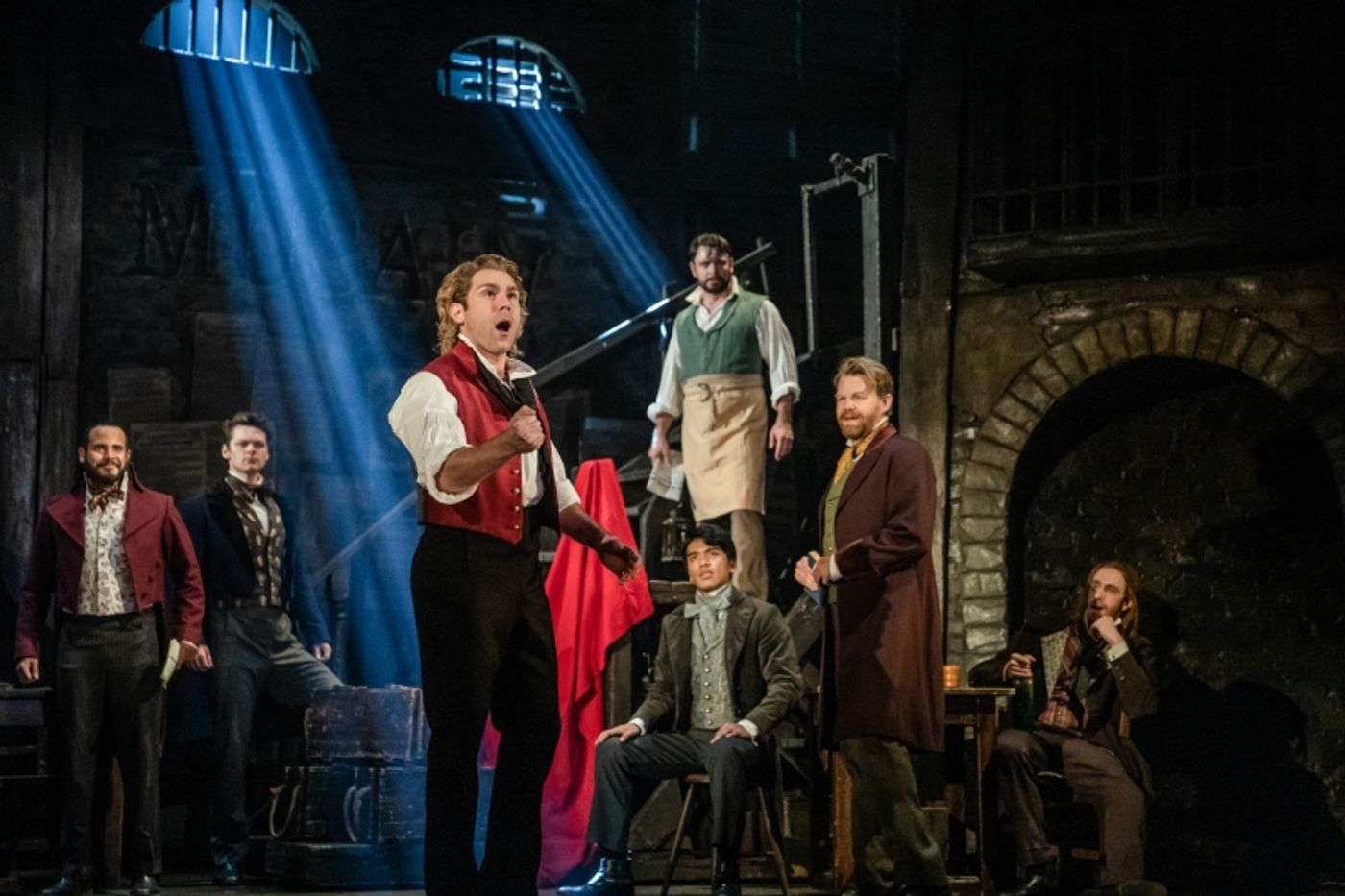
Gavroche’s climactic scene, as well as his mascot mugging among the older kids, is portrayed masterfully by Milo Maharlika. Perhaps because of the performer’s own Filipino-American heritage, Maharlika’s portrayal of Gavroche reminded me a lot of my younger brother in a “what about me, come on guys, I wanna play!” sense. Gavroche is essentially the adopted little brother of the Friends of the ABC, tagging along because he believes in the cause, but also because he wants to be seen as part of the gang. Maharlika has fun with this part, earning his place among more seasoned performers as he’s starting his own career.
Likewise, young Cosette (Azalea Wolfe) and Eponine (Ava Buesing) make their minor parts mean more than simply functioning as human props. Wolfe’s introduction includes the iconic Young Cosette illustrative pose that’s been used on every Les Misérables cover since 1985. But it’s her “Castle on a Cloud” that breaks through the applause with her cherubic innocence and birdlike notes. Ava Buesing’s younger rendition of Eponine doesn’t get to sing as much as Wolfe, though she does make her presence during “Master of the House” known. She’s inherited the same comic timing as her performing parents on stage.
The entire cast of Les Misérables comprises over forty on-stage players, of which I could only highlight a little less than half. But the ensemble players that create the populace of France deserve mention. Whether these performers are playing a farmer or a prostitute or a swindler or a soldier, they provide a sense of community to every scene. There is a true sense of unity among the entire company, no role is wasted, no part too small. In a show as technically challenging as Les Misérables, everyone must be aware of their environment at all times, walking in sync or occasionally of sync to all the action around them, not to mention shifting sets and rotating set pieces. The amount of coordination to run a forty-strong company like clockwork must have been staggering and I can only applaud them for having to do this nightly.
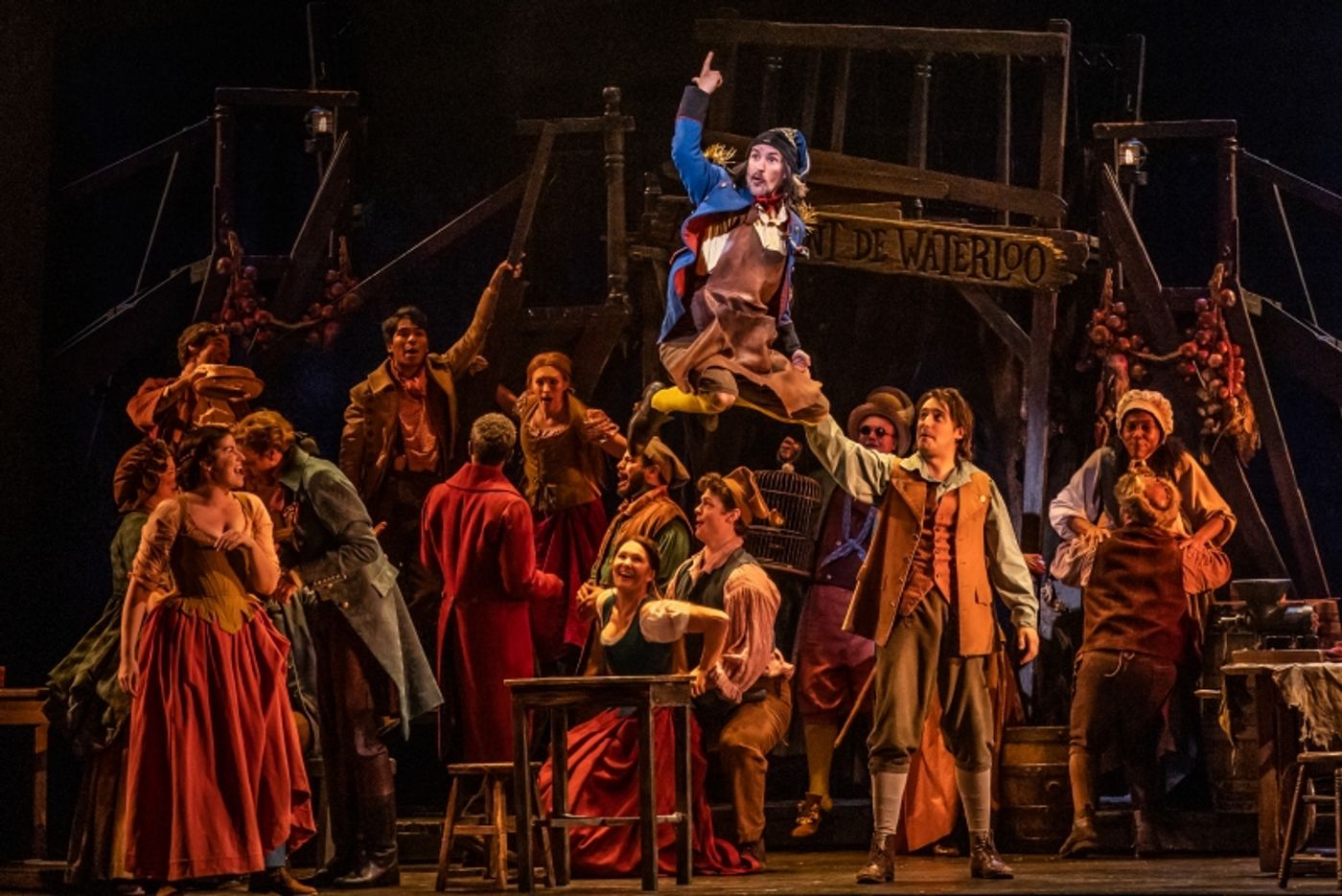
Truly, the sets of Les Misérables are as much a character as the humans on the stage. Whether it be the dirty streets of Paris, Javert’s iconic bridge, or the posh residence of Valjean, a movable set opens and closes at different intervals and gaps to create so many environments. Supported behind the practical sets are illustrative projections, based on drawings by Hugo himself, that help lend a literary quality to the scene. These projections also do not remain static. Throughout Valjean’s journey in the French sewer system, the projection shifts to create kinetic movements and, dare I say, cinematic angles that make his rescue of Marius feel more epic. Fortunately, the visions of the sewers is as far as this effect goes. While the audience could easily smell the gunpowder and smoke going off during the battle, we thankfully did not get the same smellovision technique as Valjean trudged through the sludge. A more tasteful grey fog was used.
Valjean’s saving of Marius, the one person he could rescue from the ABC, serves to drive home the sentiment of Les Misérables. If all you can save is one person, it is still worth it. In the face of failure, Valjean still managed to find redemption and peace. Marius and Cosette may be a under-written lovestruck couple. But with them, they carry the legacy of the June Rebellion. They live to tell the tale, to pass on the story of their friends and family, that others may learn of the sacrifices made for their happiness.
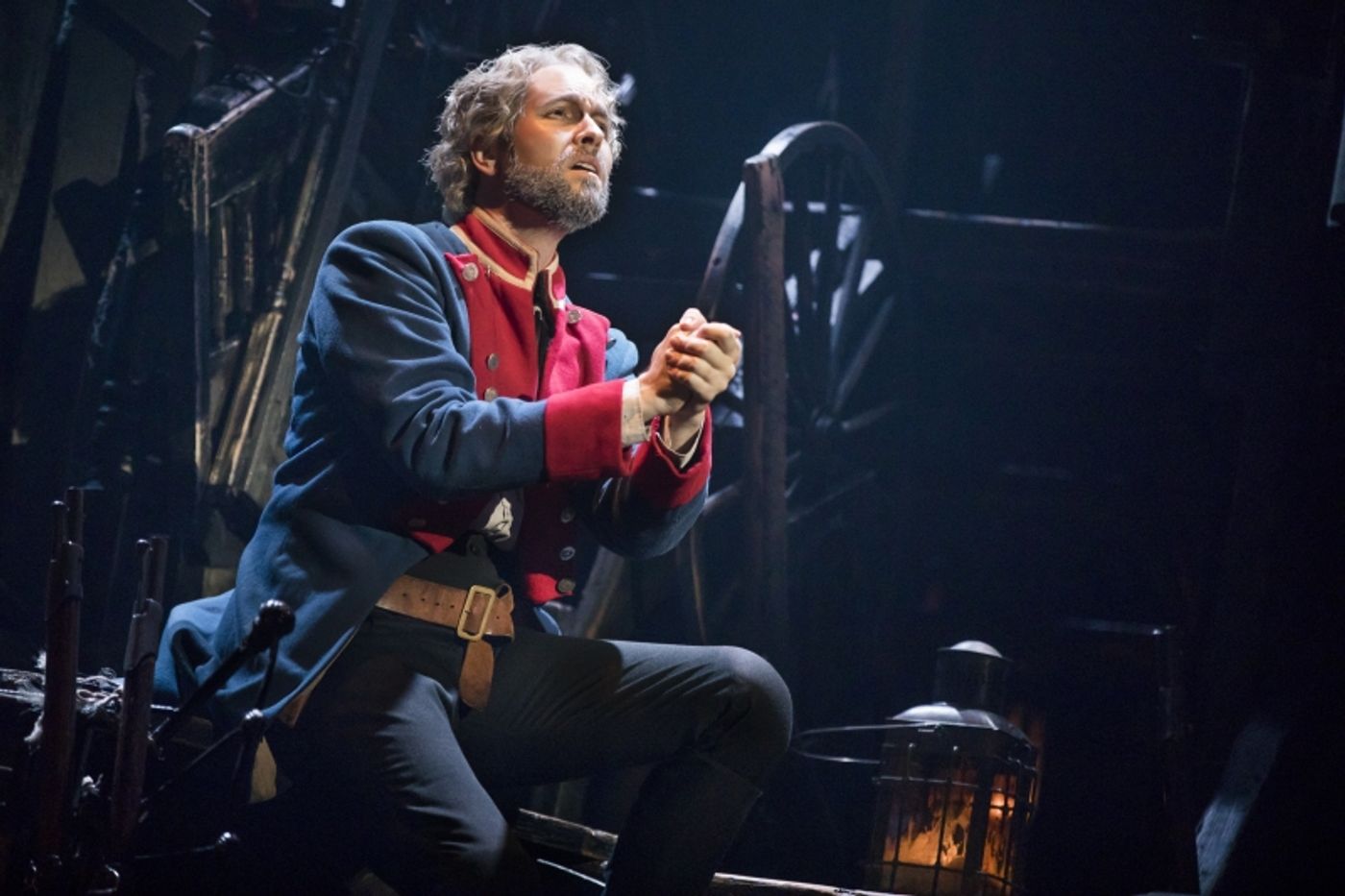
Every generation has that phase of idealistic student revolutionaries. They find a cause, an injustice, a reason to fight. The world they knew is not so perfect and needs fixing. The new radical ideas that they posit are simply the latest rendition of the previous generation's attempt. And yet, there is something so admirable in it. To lose the innocence and to fight for it back. To call to arms all those who want to make the world better than it was, to fix what has always been broken. Les Misérables is meant to inspire action amidst the mourning and the failure. That is what the audience have held on to for nearly four decades that this musical has been around. The battle on the streets of Paris was lost nearly two hundred years ago now. And the war for justice is still ongoing. Fortunately for us, Hope is winning.
The world as we know it, the desire for change and the want for equality, all of it can disappear in the blink of an eye. Nothing lasts forever, after all. Empires rise and fall, sometimes with our help, sometimes without it. But at the end of each era of a history, when all is said and done, hope survives. That is the legacy of Les Misérables. Watching the story of failure unfold, a rebellion squashed before it could spark a revolution, nobody will accurately remember who was right or who was wrong, which side was on the winning side of history. But they will be gifted the hope that came with the failure. No leader can break it, no army can crush it. It’s in the beating of the heart of every revolution, every fight for freedom, every breath taken to shout or sing. Hope brings us together through all adversity. If Les Misérables must teach its audience anything, it’s to always have Hope.

LES MISÉRABLES plays June 25 through 30 at Dr. Phillips Center. Tickets can be acquired online or at the box office, pending availability. Photos provided by official Les Miserables US Tour production company and MurphyMade Photography, used with permission.
Reader Reviews
Videos

